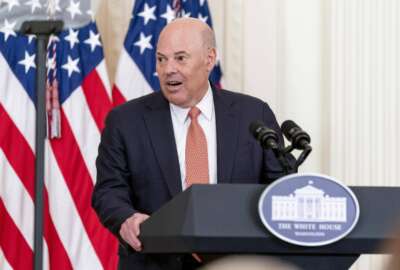
USPS vows no layoffs in its ongoing network consolidation effort
The Postal Service is telling its 635,000-employee workforce that an ongoing effort to consolidate its delivery network won’t result in layoffs.
The Postal Service is telling its 635,000-employee workforce that an ongoing effort to consolidate its delivery network won’t result in layoffs.
USPS, marking the second year of its 10-year Delivering for America plan, said it won’t lay off employees as part of plans to build Sorting and Delivery Centers (S&DCs), large facilities that bring mail processing and mail delivery operations all under one roof.
USPS said in a report released Thursday that the S&DC effort won’t result in post office closures, even at post offices that will no longer serve as outposts for letter carrier operations.
As part of the consolidation, USPS will relocate letter carriers who previously worked out of “spoke” post offices to S&DCs, which will serve as the “hub” of regional mail operations.
“Our employees will benefit from this new model through new, modern workplaces,” the report states. “There will be no employee layoffs as part of this effort. Any movement of employees will be done in accordance with the respective collective bargaining agreement.”
USPS opened its first S&DC in Athens, Georgia in November 2022, and is “already demonstrating operational benefits,” the report states.
In February, it opened an additional five S&DCs in Gainesville, Florida; Panama City, Florida; Woburn, Massachusetts; Utica, New York; and Bryan, Texas.
USPS is currently evaluating more than 100 new S&DC locations nationwide, and is looking to consolidate letter carrier operations at up to 19,000 delivery units (DUs) — the post offices and postal annexes that are the last stop for mail and packages before they go out for household delivery.
“Historically, DUs were opened to meet growing demand, which ultimately created clusters of facilities close to each other, especially in busy metro areas,” the report states. “In addition to the inherent cost of maintaining these key DUs, this network had become operationally inefficient.”
Meanwhile, USPS’s regulator is reviewing the agency’s plans to consolidate its delivery network.
The Postal Regulatory Commission is launching a public-inquiry proceeding to better understand how the S&DC plans will impact USPS costs and performance.
The commission’s inquiry seeks to shed light on details of the overall S&DC plan that have not yet been shared with the postal community or the public.
Edmund Carley, national president of the United Postmasters and Managers of America, said the S&DC effort is looking to optimize the agency’s network operations, but it remains unclear if the project would result in savings.
“Revamping the network, maybe looking at [fewer] trucks moving longer distances, with more mail in them — all of that is a positive development, and should, in the long-term, make it more efficient,” Carley said. “The problem is, does it translate to more revenue?”
Ivan Butts, president of the National Association of Postal Supervisors, said he’s been “seeing a lot of things happening, in terms of capital” at USPS.
USPS is embarking on $40 billion in long-deferred capital investments, including the acquisition of its mostly electric next-generation delivery fleet, new mail and package sortation equipment and the S&DCs. Butts, however, said it remains unclear just what the overall impact of these investments will be.
“We’re just not sure where all these changes are leading us to,” Butts said. “We still have a lot to see.”
American Postal Workers Union President Mark Dimonstein said APWU remains unsure if the S&DC consolidation effort is going to improve or diminish USPS service.
“Our feelings are mixed,” he said. “If they’re going to diminish service, then we’re going to unite with the people of the country to say no. If it’s going to improve service — even if it’s going to be a transition that’s going to be challenging — then we have a very different view of it.”
USPS, two years into its 10-year reform, has cut its projected losses for the next decade in half — from $160 billion to $70 billion.
The agency is currently not on track to break even in fiscal 2023, as it once expected, but expects its ultimate goal of zeroing out that projected loss over the next decade, and reaching “break-even” status by 2030 remains in sight.
“That is significant progress toward our 2030 10-year break-even goal,” the report states. “Even with the unexpected burden of inflation, the organization still forecasts we can achieve break-even operations by the end of DFA’s 10-year period.”
USPS’s commitment to no layoffs brings some clarity to what the S&DC effort would mean for its workforce.
Postmaster General Louis DeJoy, when asked about the S&DC effort last summer, said USPS may need to shed 50,000 positions over the next decade. He added that any reduction of the USPS workforce, if needed, would occur through normal attrition —in other words, employees retiring or voluntarily leaving the agency.
“Right now, to get to break even, I think we may need to get 50,000 people out of the organization. But that’s OK, because over [the next 10 years] 200,000 people leave the organization for retirement,” DeJoy said at the American Enterprise Institute. “So we’re going to be a hiring organization. We need to be good at retention, we need to be good at recruiting people, and we’re doing a lot of different activity around there.”
Copyright © 2025 Federal News Network. All rights reserved. This website is not intended for users located within the European Economic Area.
Jory Heckman is a reporter at Federal News Network covering U.S. Postal Service, IRS, big data and technology issues.
Follow @jheckmanWFED





